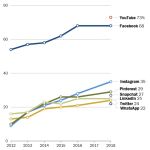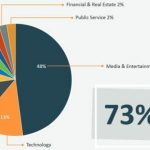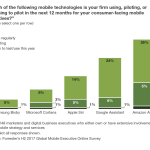Forrester: Marketers Still Struggling To Understand Mobile
Forrester: Marketers Still Struggling To Understand Mobile
by Laurie Sullivan @lauriesullivan, (December 22, 2017)

Marketers face a steep learning curve this year when it comes to mobile advertising. Banner ads still prevail, first and last-click attribution are more common than they should be, and demographic targeting dwarfs more contextual approaches to personalization, according to a study released from Forrester Research.
Mobile marketers tend to favor accuracy over reach. Demographic targeting remains the most common form of ad targeting on mobile, followed by behavioral targeting and search and site retargeting. Few marketers use contextual inputs such as location, time of day, or weather data because they do not trust the measurement and data resources.
As noted in an earlier Forrester study titled Forrester/MMA Q3 2017 Global Mobile Advertising Benchmark Online Survey, 47% of marketers are willing to sacrifice some reach in exchange for precision. About 32% will sacrifice some precision in change for reach. And 15% say they have a minimum reach and precision requirement.
The joint study, released this week from Forrester Research and the Mobile Marketing Association, found that most marketers are gearing up to connect with consumers on mobile devices, but acknowledge that they struggle to build the correct skills and partners.
More than half agree they don’t lack sufficient resources assigned to mobile advertising, and only 42% believe their teams have the necessary skills. Some 64% of respondents say mobile is still siloed, They also identify collaboration across international divisions as a top challenge.
Ironically, marketers are unsure which technology partners they will need. Marketers still struggle to grasp the mobile advertising ecosystem in which fragmentation across channels still exists. It creates confusion and uncertainty, and about 36% acknowledge that they don’t know whether they have the right partners.
Still, despite all this uncertainty, only 28% of marketers say mobile is not a priority. They also point to mobile data quality and accuracy as top challenges.
On average, about one-third of advertisers cannot tell whether specific ad formats are efficient in driving performance. They have the least amount of faith in interstitials, outstream, and vertical video ads running on mobile devices. They are unable to measure whether, and to what extent, they have a positive return on investment. “This dooms formats that claim higher CPMs — in particular video and interactive, rich media inventory,” according to the report.
Still, 74% of marketers surveyed expect to see their company’s mobile ad budget increase in the next 12 months, while 32% expect an increase of between 15% and 30%. Some 42% say their budget will increase between 1% and 14%, with 19% saying it will remain the same.
Some marketers admit to reducing their mobile budgets. Between 1% and 4% say they will decrease their budget by 5%, and between 15% and 29% will decrease their budget by 2%. The data was based on 186 responses.
Forrester reports that these growth trends match its mobile advertising forecast, which projects that U.S. mobile display and social ad spend will grow from $25.5 billion in 2017 to $50.5 billion by 2021.
MediaPost.com: Search Marketing Daily
(16)













